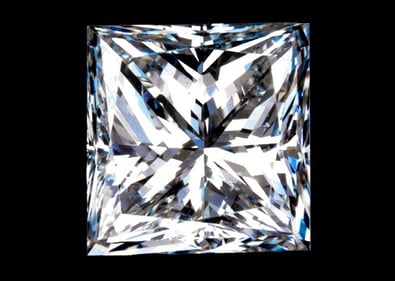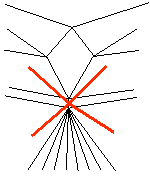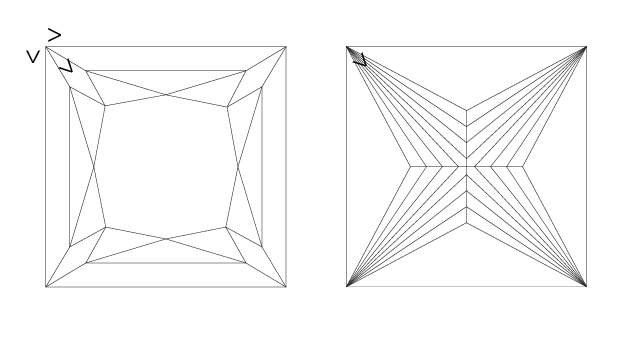
One of the things we have discovered after serving the jewelry industry for many years through our dedicated diamond re-cut and repair service is that Princesses form a disproportionate percentage of repairs. It is also the most abused and butchered of all diamond shapes. Over the years I have seen it all. Out of center culets, misaligned girdles, no girdles, Great Wall of China girdles, steep and flat facet groups and diamonds proportionately compromised with weights that they had no right to. But that is not all.
Many well cut princesses have come to us over the years with broken points, which is a classic case of Princess turning into Cinderella. Often the setter is blamed for broken points for not allowing enough ‘fresh air’ in the prongs to prevent them from touching the points. In order to understand why the points are chipping, we need to look at the crystal structure. We have to bear in mind that the atomic structure of diamonds makes them anisotropic, meaning their crystal faces have varying degrees of hardness and directions of cutting.
The Atomic Structure of a Diamond
All diamonds have 8 octahedral faces, which equates to 4 octahedral or tetrahedral planes. The reason for half the number of planes is due to the fact that every face has an opposite parallel face. Likewise does each diamond have 6 cube or hexahedral faces yet half the number (i.e. 3) cube planes. All diamonds also have 12 dodecahedral faces and logically 6 dodecahedral planes as each face has an opposite parallel counterpart. Geometrically, the dodecahedral faces intersect at the cube faces, where 4 of them meet. Likewise they intersect or meet at the octahedral faces, where 3 of them would intersect. Due to the atomic structure of diamonds, the octahedral faces are the hardest to cut and polish, followed by the cube faces. In fact cutting parallel to the octahedral faces is impossible and cutting parallel to the cube faces are near impossible. The dodecahedral faces are the softest faces to cut and polish on a diamond. This causes a problem for the princess cut diamond. The points of a princess cut normally coincide with four cube faces of a diamond. The other two cube faces are on the culet and table, respectively.
Following is an image showing the red outline of the four dodecahedral faces (110 for those that are familiar with the Miller indices) where they meet at the point of the princess.

Why Princess Cut Diamonds are Prone to Chipping
As four dodecahedral faces intersect on each cube face, it stands to reason that we have four ‘weak’ faces intersecting at the points of a princess. It follows naturally that each point has the potential to chip or flake in four different directions. Compounded, we are talking of 16 directions towards which the points can chip. The following diagrams show the directions towards which the points of a princess can chip as indicated by the arrows.

How Can This Problem in Princesses be Mitigated?
By cutting tiny chamfers on the points. This creates a flat surface coinciding with the very strong cube face. The chamfer removes the risk of facets ‘flaking’ off in the various directions. I once had the misfortune of just touching a point on a princess with a loupe and it chipped! Yes, they are that vulnerable.
Chamfers are cut perpendicular to the table and at 45° to the adjoining girdle facets and this is what they look like:

By cutting these tiny chamfers on princess cuts, the risk of chipping is greatly diminished. The only time a princess cut with chamfers is going to break is in a case of a severe blow to the setting. In the interest of protecting clients and the future value of their investment, jewelers should look for princess cuts with chamfers, or consider alternative designs in square designs like radiants or cushions.
Remember the industry and our individual reputations are on the line!


 RapNet Blog
RapNet Blog





